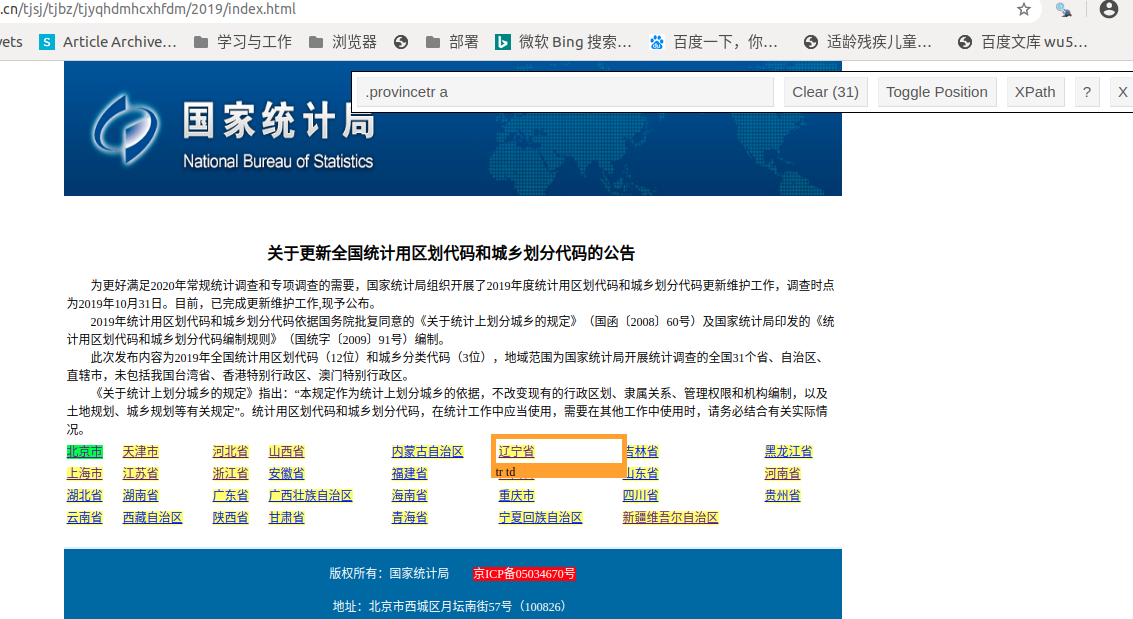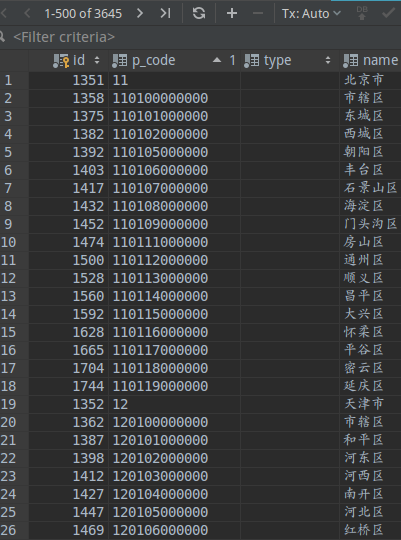不知不觉养成了一个习惯:完成一个工作或学习新知识后,要及时整理,否则过一段时间就忘记了。
下面是用scrapy 爬虫框架读取行政区划的记录
1. SelectorGadget 是个好东西,下载和安装可以网上查
安装后,会在crome浏览器右上角有个图标。


点击 右上角这个图标后,进入css选取模式, (1)点击网页内容,被选取内容显示黄色,同时css选择器会显示在控制面板上。(2)再点击黄色内容,会变红色,表示排除这一项标签。
如图: 表示选取了各省,同时,排除了“京icp备...”
2. 利用scrapy框架爬虫
# -*- coding: utf-8 -*- import scrapy from scrapy import Request from ..items import * from scrapy import Request from scrapy.http import Request class JgSpider(scrapy.Spider): name = 'jgspider' allowed_domains = ['stats.gov.cn'] start_urls = ['http://www.stats.gov.cn/tjsj/tjbz/tjyqhdmhcxhfdm/2019/index.html'] def parse(self, response): print('begin-----------') # 省级 for node in response.css('.provincetr a'): item = Class1_Item() item['name']= node.css('a::text').get() next_page=node.css('a::attr(href)').get() item['code']=next_page.split('.')[0] yield item if next_page: next_page = response.urljoin(next_page) yield scrapy.Request(next_page, callback=self.parse2) def parse2(self, response): # 市级 for node in response.css('.citytr'): item = Class1_Item() item['code'] = node.css('a::text').getall()[0] item['name'] = node.css('a::text').getall()[1] next_page=node.css('a::attr(href)')[0].get() yield item if next_page: next_page = response.urljoin(next_page) yield scrapy.Request(next_page, callback=self.parse3) def parse3(self, response): # 县级 for node in response.css('tr.countytr'): item = Class1_Item() if node.css('td::text').get() !=None: item['code'] = node.css('td ::text').getall()[0] # 要提取text,html tag必须探底 item['name'] = node.css('td ::text').getall()[1] else: item['code'] = node.css('td a::text').getall()[0]#要提取text,html tag必须探底 item['name'] = node.css('td a::text').getall()[1] yield item next_page = node.css('a::attr(href)').get() if next_page: pass
我只爬到区县一级,没再读取乡村镇社区。重要的内容都下载备注。数据如下:

3. 认清本质,快速理解,才能快速上手
参考:https://djangoadventures.com/crawling-pages-with-scrapy/
1.Request & Response
import scrapy def parse(response): # do something with the response pass # making a request with a callback that we've defined above scrapy.Request('http://example.com', callback=parse)
(1)向 Request 传入url 并发起请求
(2)收到 Response object ,Response作为参数,传入callback函数
(3) A callback is a function which will be invoked by the Request object once the request has finished its job. The result of the request’s job is a Response object which is passed to the callback function. A callback is sometimes called a handler.
Response is basically a string with the HTML code of the page we’ve requeste
Response其实就是html字符串,重点内容是parse这个字符串,提取我们需要的内容
2.Selectors
这是重点内容,我单独开篇:css选择器 https://www.cnblogs.com/lxgbky/p/12697801.html
3.Spider
爬虫主体逻辑,在这里,发起requests、解析 responses. The main method in a Spider class is start_requests.
(1)是爬虫的入口 — when it is invoked, it launches the start_requests function. This function usually contains your initial Request invocations.
(2)callback functions中,可以解析出url,进一步request.
like a tree with a root at start_requests
start_requests
sub requests
requests
requests
sub requests
requests
requests
class ExampleSpider(scrapy.Spider): def start_requests(self): # invoking initial request yield scrapy.Request('http://example.com', self.parse) def parse(self, response): # parsing response from the initial request # collecting links links = response.css('a.title::attr(href)').extract() for link in links: # make a request for each link we've collected # the handler is different from the one we had # in initial request yield scrapy.Request(link, self.parse_page) def parse_page(self, response): # parsing response from each link title = response.css('h1.title::text').extract() content = response.css('div.content p').extract() # returning structured data for further processing yield {'title': title, 'content': content}
框架流程非常共通化,所以可以框架提供了简化写法,如下:
This simple parser scenario is so common that there is a shortcut to reduce the boilerplate. Here’s a reduced example:
class SimpleSpider(scrapy.Spider): # those are the initial urls that you used to write # in a start_requests method. A request will be invoked # for each url in this list start_urls = ['http://example.com'] # this method will be called automatically for each # finished request from the start_urls. def parse(self, response): # you can either parse the response and return the data # or you can collect further urls and create additional # handlers for them, like we did with parse_page previously
省略了start_requests, 默认的start_requests自动调用start_urls,并回调传参给parse
4. Pipeline
pipeline是最后清理垃圾,保存数据的地方。有3个函数
(1) process_item method which is invoked for each piece of data returned from the spider.
In this function we usually clean the data or save it to a database.
(2) open_spider and close_spider.
方法的使用说明看代码注释
from markparser.storage import get_session, Place class MarkparserPipeline(object): def open_spider(self, spider): # this method is invoked once the spider # is initialized. No requests have been # made at this point yet self.session = get_session() def close_spider(self, spider): # this method is invoked when the spider # is about to exit. All requests have been # made already. self.session.close() def process_item(self, item, spider): # here we place our item processing logic # we can either modify our data and pass it on # for further processing or we can save this # item to a database and finish the execution record = Place(**item) self.session.add(record) self.session.commit() return item
下面是下载行政区划的pipline, 与django结合,使用django的model保存生成的item.
from jgapp.models import Jg class ScrapyProjectPipeline(object): def process_item(self, item, spider): try: jg = Jg.objects.get(p_code=item['code']) print("jg already exist") return item except Jg.DoesNotExist: pass jg = Jg() jg.p_code = item["code"] jg.name = item["name"] jg.save() return item
scrapy和django结合的关键是,在scrapy的setting.py中,加入启动django的代码
import os import sys import django sys.path.append(os.path.join(os.path.dirname(os.path.dirname(os.path.abspath(__file__))), "..")) sys.path.append(os.path.dirname(os.path.dirname(os.path.abspath(__file__)))) os.environ['DJANGO_SETTINGS_MODULE'] = 'django_project.settings' django.setup()

完!